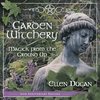Secrets of a Green-Thumbed Witch: Tarot and Gardening

Growing a sacred garden can be a delight, but when leaves wither and plants begin to die, feelings of hopelessness and disappointment emerge. Such desperation can make chemical fertilizers tempting, but often, all that's needed in the garden is a little magic. With each growing season, we have a fresh opportunity to improve our skills as both gardener and Witch. We want to do all we can to grow our best gardens yet, and this includes trying out new magical methods to improve our crops.
One such technique that is easy to learn and very beneficial is to use Tarot cards to help maintain the health of plants in the garden. Tarot cards can reveal a failing plant's specific ailment and needs, and can also be used to increase vitality and enhance growth, calling on essential elements in the environment that will sustain and protect your plants.
If you have a plant that is showing signs of distress or that is growing more slowly than expected, sit next to it with one of your Tarot decks and mix the cards, focusing on the plant's energies. Absorb the vibrations of the plant and send this power through your fingertips and into the cards. Ask the plant what is wrong, and draw a card for the answer.
As your ability to creatively apply your knowledge of the Tarot will determine the quality of your garden diagnosis, it's a good idea to study up on various aspects of Tarot symbolism and interpretation. Intuition is your primary tool, but it needs a firm foundation of knowledge on which to operate. Seek out both new and classic guides to the Tarot, and strive to never rely solely upon one reference. By learning a multitude of possible associations for each card, you will give yourself a broad base of information to help you develop your own interpretations.
Here are some general interpretive guidelines to get you started in the right direction. With a traditional Tarot deck, drawing an upright cup card can show that the plant needs more water, as cups are the suit of this element. A reversed cup card may signify that the plant is being over watered. Likewise, an upright wand card can reveal that the soil needs to be better aerated, while a reversed wand card shows that the plant might need to be buffered from the wind. A sword card likely points to disease or overcrowding, and if the card is reversed, it can signify that the damage may already be beyond rectification. An upright pentacle card communicates that the plant may need stronger protection against pests, while a reversed pentacle card can show an imbalance in soil composition or a need for more nutrients. An upright Major Arcana card can be interpreted as a sign that the plant needs more light, and a reversed Major Arcana card may mean that the plant needs to be shaded.
For those with a more advanced understanding of the Tarot, interpretations of chosen cards can be more detailed and the diagnosis of the plant's ailment more specific and complete. For instance, the Five of Pentacles in the Rider-Waite-Smith deck, with its imagery of starving figures left out in the cold, could be taken to signify that the plant is plagued by a pest that is cutting off its access to nourishment. A worm or insect could be feasting on the roots of your little green friend. As another example, the Eight of Swords, with its symbolism of confinement, could be interpreted to mean that the plant is being restrained. Another plant could be wrapping around it or crowding it, or if it's a container plant, it might need to be moved to a larger pot. The more familiar you are with the Tarot, the easier will it be to make the most of your intuition when interpreting the cards to diagnose the health of your magical garden.
With contemporary decks that stray from traditional imagery, you will need to rely solely on your psychism to supplement the information in the interpretive guide to your particular card set. Unlike the traditional Tarot, fairy cards and similar sets do not have the benefit of having been written about for centuries, and there is simply a lack of available cross-references for studying the newer decks. Don't let this discourage you from investigating these cards, however. Many contemporary decks retain accuracy while offering a fresh perspective that can expand your magical skills and sharpen your intuitive faculties.
No matter which deck you use to analyze your garden, it is important to be objective when interpreting the cards. Our desires for a healthy garden may cloud our judgment, causing us to overlook obvious warnings of plant illness and other problems. Be aware of personal bias, and your interpretations will be accurate.
In addition to diagnosing the specific needs and ailments of plants, the Tarot can also be used to increase plant growth and improve your garden's overall vitality. The cards can act as symbols through which to invite natural elements to magically protect and support the growth of your plantings. Create your own ceremony, or try this effective ritual.
Take with you into the garden the Ace of Cups, the Ace of Wands, the Ace of Pentacles, and The Sun. The Ace of Swords may be substituted for The Sun card if you wish. With contemporary decks, simply choose whichever cards best represent the earthly elements that your plants need to flourish: earth, air, water, and light.
To begin the ritual, hold the Ace of Cups or an alternative water card into the air and say, "Powers of water, please do all you can for my garden."
Next, hold the Ace of Wands or other air card and plead, "Powers of air, please be kind and helpful to my garden."
The Ace of Pentacles or an alternative earth card is next. Take it into your hands and say, "Earth, be rich, so that my seeds will grow. Please do all you can to protect and sustain this garden."
Finally, hold The Sun or an alternative fire (light) card into the air and request, "Powers of sunlight, please shine on this garden in proper measure and magnify its bounty."
Express your gratitude to the elements and the ritual is complete.
By trying these new Tarot techniques this spring, you're likely to have prolific growth in the garden as well as in your magical spirit; celebrate both by sharing the fruits of your harvest. Man is not meant to fend solely for himself, working in isolation for money with which to buy a chemical-laden frozen dinner. Other social animals live in harmony with nature and work cooperatively towards the good of their species. By applying locally a global perspective to sacred gardening, using magical skills and technical knowledge to make sure your backyard garden is healthy for the plants you grow, for your community, and for the world, you will reaffirm and deepen your connection to nature. Your garden will produce such a magnificent bounty that there will be plenty to share with other people. You won't be able to grow enough beans to feed the world, but you can easily grow enough rosemary to share with your witchy friends, or produce enough tomatoes to keep the guy down the street from having to purchase any all season.
The ultimate goal of sacred gardening, and of all other branches of positive magic, is simple: to benefit the earth and humanity by increasing love and light and alleviating suffering. By using any sort of magic in the garden, be it diagnosing plant health with the Tarot or using crystals to speed growth, you are making a pact with the sacred. Nature will care for you only if you care for Nature, so when your magic succeeds and you gather your garden harvest, show your love and consideration by doing all you can to share the blessing. Loving magic, and magically loving, after all, is what true witchery is all about.

About Melanie Marquis
Related Products



is subject to certain Terms and Conditions